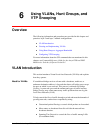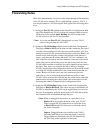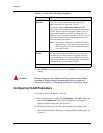
Document No. 10-300077, Issue 2 6-7
Using VLANs, Hunt Groups, and VTP Snooping
CAUTION:
Creating and Implementing VLANs
Adding users to VLANs include:
■ VLAN Considerations
■ Creating a VLAN
■ Configuring VLAN Parameters
■ Assigning Ports to VLANs
VLAN Considerations
Be aware of the following issues when configuring VLANs:
■ If you set Trunk Mode to Clear, you must set the VLAN Binding
Type to Static (default).
■ The switch supports a feature called Automatic VLAN Creation
for tagged frames. When this feature is enabled, the switch creates
new VLANs when it receives packets from previously unknown
VLANs. Vlan’s can be created automatically without manually
creating the VLAN on each switch.
■ Automatic VLAN Creation does not work on an 80-series
supervisor module (M8000R-SUP) if the Port default VLAN is set
to discard.
■ If you enable Automatic VLAN Creation AND set “VLAN
Binding” type to Bind to Received, make sure that you set the
binding type before enabling Automatic VLAN Creation or else
the port may not be automatically added to the VLAN.
■ Assigning one of the ports of a 48-port module to a VLAN for
which there exists IP interface will force that interface to be in the
UP state, even when there is no physical connection to the module.
Creating a VLAN
You can create a VLAN using either the Web Agent or the CLI.
Before creating or adding additional VLANS, it is strongly
recommended that you review the contents of this chapter and
Chapter 9, “Managing the Address Forwarding Table.”


















